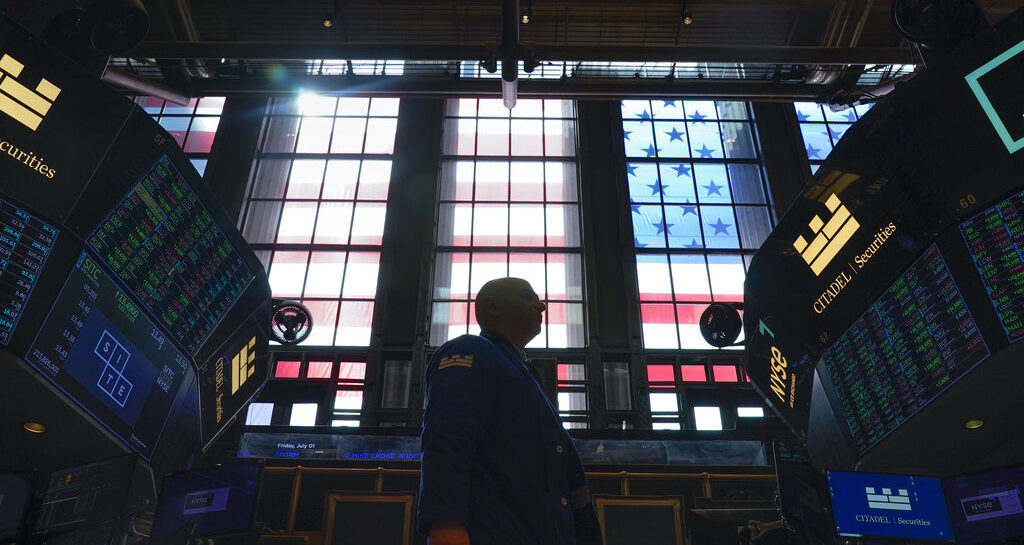[ad_1]
Stocks indexes on Wall Street are wavering in afternoon trading Wednesday, giving up some of their gains from an early rally as more profit reports roll in from U.S. companies.
The S&P 500 was 0.2% higher after having been up 1% in the early going. The benchmark index soared 2.8% on Tuesday, its best day in weeks. The Dow Jones Industrial Average shed a midday gain and slid into the red, down 98 points, or 0.3%, at 31,725, as of 2:09 p.m. Eastern time. The Nasdaq composite was 1% higher after having been up 1.9% in morning trading.
Profit reporting season is ramping up, with more types of industries offering details about how high inflation and worries about a possible recession are affecting their customers. A lot is riding on whether they can continue to deliver healthy earnings.
Stocks tumbled roughly 20% from their highs this year because of rising interest rates, and proof that profits can remain strong would provide a big support for markets. On the other hand, warnings about upcoming weakness could kick off another leg downward.
Companies so far have been mostly topping profit expectations this reporting season, as is usually the case, though the most recent reports were mixed.
Nasdaq, the company behind its namesake trading exchange, jumped 5.9% after delivering stronger profit and revenue than Wall Street expected. Omnicon Group, the advertising and public-relations company, rose 3.2% following better-than-expected earnings. Comerica, the Dallas-based financial services company, added 0.5% after it also reported stronger-than-expected results.
Netflix climbed 5.5% higher after it said it lost fewer subscribers during the spring than expected. It, though, remains the worst stock in the S&P 500 for the year, down by nearly two thirds.
Beyond Netflix, several other tech-oriented companies were making strong gains. Amazon climbed 4.1%, and Nvidia jumped 4.3%, helping the Nasdaq composite index to be the market’s clear leader.
On the losing end was Baker Hughes, which tumbled 8% after it reported weaker results for the spring than analysts expected. Northern Trust fell 4.8% after its profit fell short of forecasts.
In Europe, stocks slipped amid worries about whether Russia would restrict supplies of natural gas headed for the region after some maintenance on a key pipeline is scheduled to end Thursday. Germany’s DAX fell 0.2%, and French stocks dipped 0.3%.
The continent is also preparing for the first increase in interest rates by the European Central Bank in 11 years on Thursday, as it tries to beat back inflation.
The U.S. Federal Reserve has already hiked rates three times this year, by increasing margins each time. When it meets next week, investors say the only question is if it raises its key rate by another 0.75 percentage points or opts for a mega-hike of a full percentage point.
Expectations have recently been tilting toward the less aggressive option, with traders seeing better than a two-in-three chance for a 0.75-point increase, according to CME Group. That could mean less pressure on stocks, particularly tech stocks and others seen as the market’s more expensive, which have swung sharply with changes in forecast on what the Fed will do.
Such increases to rates make borrowing more expensive, which slows the economy. The hope is that the Federal Reserve and other central banks can deftly find the middle ground where the economy slows enough to whip inflation but not enough to cause a recession.
Some parts of the economy are already slowing because of the rate hikes, particularly the housing industry. A report on Wednesday morning showed that sales of previously occupied homes weakened last month by more than economists expected. Higher mortgage rates are dragging on the industry, along with high prices for homes.
In the bond market, the yield on the two-year Treasury, which tends to follow expectations for the Fed’s actions, edged up to 3.25% from 3.24% late Tuesday. The 10-year yield rose to 3.03% from 3.01% late Tuesday.
[ad_2]
Image and article originally from libn.com. Read the original article here.

